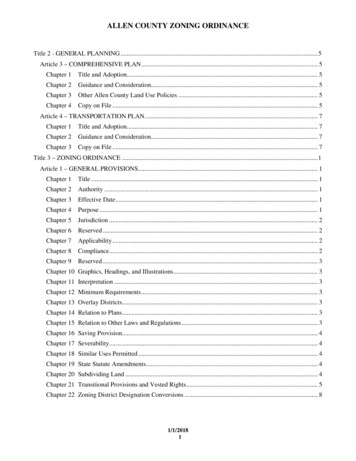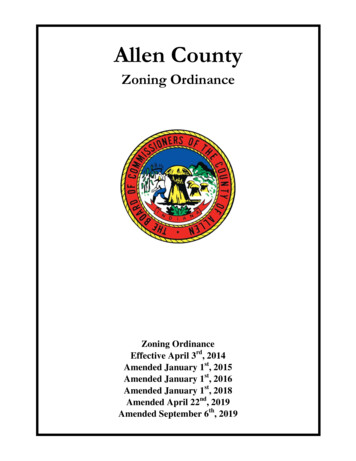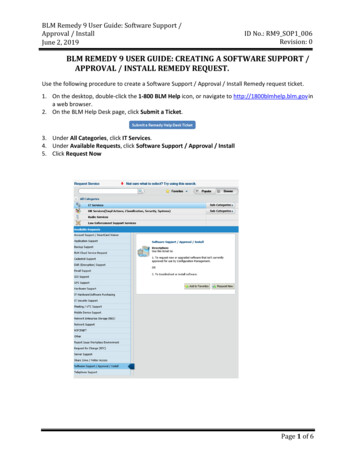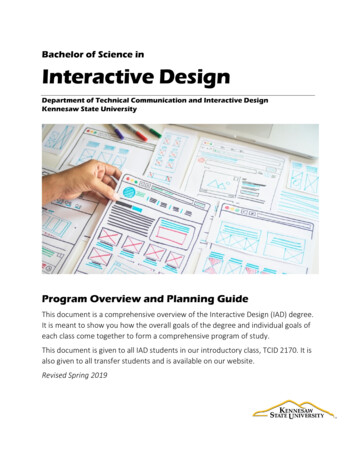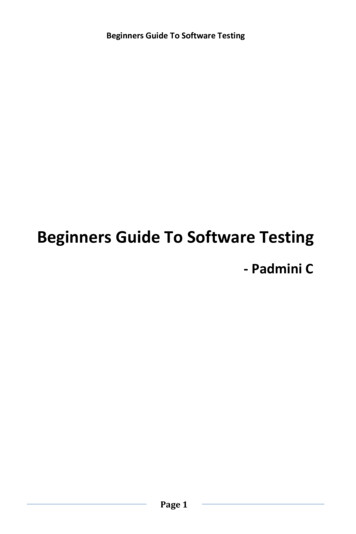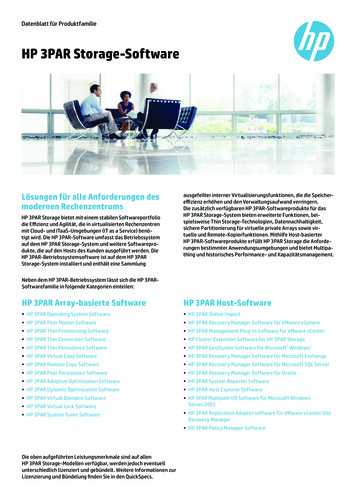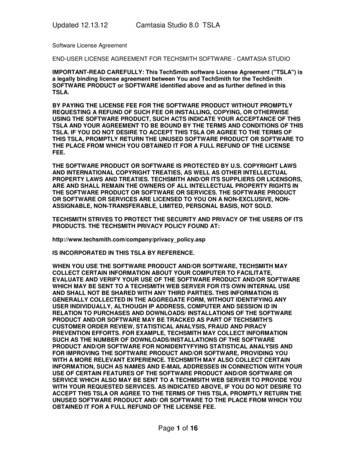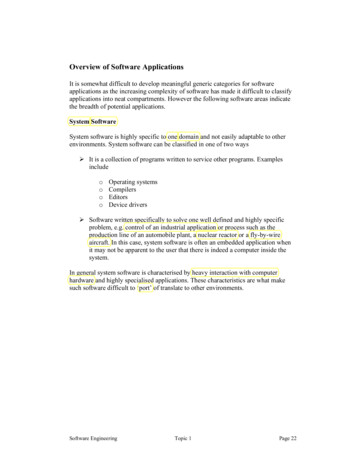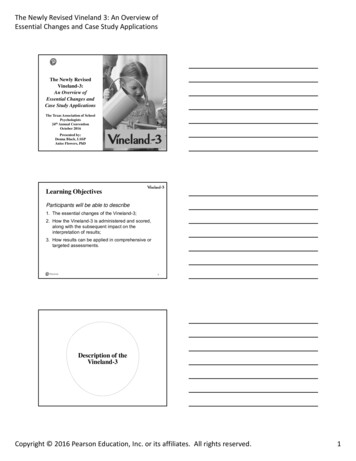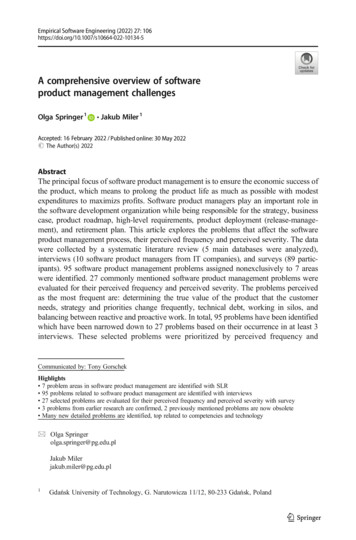
Transcription
Empirical Software Engineering (2022) 27: 106https://doi.org/10.1007/s10664-022-10134-5A comprehensive overview of softwareproduct management challengesOlga Springer 1& Jakub Miler1Accepted: 16 February 2022 / Published online: 30 May 2022# The Author(s) 2022AbstractThe principal focus of software product management is to ensure the economic success ofthe product, which means to prolong the product life as much as possible with modestexpenditures to maximizs profits. Software product managers play an important role inthe software development organization while being responsible for the strategy, businesscase, product roadmap, high-level requirements, product deployment (release-management), and retirement plan. This article explores the problems that affect the softwareproduct management process, their perceived frequency and perceived severity. The datawere collected by a systematic literature review (5 main databases were analyzed),interviews (10 software product managers from IT companies), and surveys (89 participants). 95 software product management problems assigned nonexclusively to 7 areaswere identified. 27 commonly mentioned software product management problems wereevaluated for their perceived frequency and perceived severity. The problems perceivedas the most frequent are: determining the true value of the product that the customerneeds, strategy and priorities change frequently, technical debt, working in silos, andbalancing between reactive and proactive work. In total, 95 problems have been identifiedwhich have been narrowed down to 27 problems based on their occurrence in at least 3interviews. These selected problems were prioritized by perceived frequency andCommunicated by: Tony GorschekHighlights 7 problem areas in software product management are identified with SLR 95 problems related to software product management are identified with interviews 27 selected problems are evaluated for their perceived frequency and perceived severity with survey 3 problems from earlier research are confirmed, 2 previously mentioned problems are now obsolete Many new detailed problems are identified, top related to competencies and technology* Olga Springerolga.springer@pg.edu.plJakub Milerjakub.miler@pg.edu.pl1Gdańsk University of Technology, G. Narutowicza 11/12, 80-233 Gdańsk, Poland
106 Page 2 of 38Empirical Software Engineering (2022) 27: 106perceived severity. Some of the identified problems spanned beyond the software productmanagement process itself, but they all affect the work of software product managers.Keywords Software product management . Software product manager . Product development .Survey1 IntroductionThe objective of software product management (SPM) is to “prolong product life, as much aspossible with modest expenditures to maximize profits, and retain market leadership.” Productmanagement responsibilities are crucial in software companies, as these responsibilitiessupport the decision-making process and the development of valuable products (Kittlaus andFricker 2017). Software product management is a set of processes aimed at defining, introducing, developing, growing, maintaining and withdrawing a software product on the market.It is closely related to other areas of software engineering such as: strategy development,requirements engineering, project management, agile software development, product marketing, and business analysis (International Institute of Business Analysis 2015; Project Management Institute (PMI) 2017). It differs from project management in that it focuses more oncustomers, sales, user feedback and constant product growth. Products are commonly developed without a fixed time limit by a number of projects in a bigger timescale. Agile and Leanapproaches share a user-centered perspective and fast business value delivery with the softwareproduct management, although they do not cover the more strategic levels of productdevelopment. Business analysis covers an important part of product management, but it lacksa technical viewpoint. Software product management effectively spans all of these areas.Software product management is becoming increasingly integrated into the commonly usedsoftware development and management frameworks in the IT industry (CollabNet VersionOne2019; Schwaber and Sutherland 2017; Scaled Agile Inc. 2019). Scrum supports productmanagement as a framework, as it allows to continuously improve the product, the team,and the working environment. Scrum Guide introduces the role of the Product Owner, which isresponsible for business goals and value, although it does not specify precisely how this roleshould be performed effectively (Schwaber and Sutherland 2017). Project managementmethodologies and guidelines such as PRINCE2 and PMBoK focus on project deliveryand techniques for project managers, rather than on how to create a valuable product forcustomers (Project Management Institute (PMI) 2017; AXELOS 2017). The comprehensivesoftware engineering-related resources do not include software product management as a topicconnected to software development (Sommerville 2015). On the other hand, the genericproduct management and development guidelines and models do not focus on the specificaspects of software as a market product or service (Geracie and Eppinger 2013; CMMIInstitute 2019).The problems and risks related to project management, requirements engineering, Agile, orUX are already widely discussed in the literature (Lopez et al. 2016; Fernández and Wagner2015; Kagan et al. 2016; Uusitalo et al. 2019). For software product management specifically,the key article focused on the SPM problems is titled “Lean Solutions to Software ProductManagement Problems” by Maglyas et al. (2012) (Maglyas et al. 2012a). They compiled ashort list of 5 quite generic problems, although without any information about their occurrenceor scale of impact on product management. This indicates that the research in the topic of the
Empirical Software Engineering (2022) 27: 106Page 3 of 38 106problems of software product management is still open, as the understanding of the specificproblems and the evaluation of their frequency and severity require further study (Maglyaset al. 2013; Ebert and Brinkkemper 2014; Maglyas et al. 2017; Jantunen et al. 2013; Bekkerset al. 2012). This is why we found it crucial to understand the problems of software productmanagement more deeply, and to update the information from 2012.The goal of this research is to identify and evaluate the problems of software productmanagement from the perspective of software product managers. The research questions are asfollows:RQ1: What problems are recognized by Software Product Managers?RQ2: What is the perceived frequency of software product management problems bysoftware product managers?RQ3: What is the perceived severity of software product management problems bysoftware product managers?The article is structured as follows. Section 2 provides the theoretical background of ourresearch, the software product management frameworks and processes, the role of asoftware product manager and an overview of the previously identified software productmanagement problems. In section 3 we describe our research method including asystematic literature review, interviews, and survey. Section 4 reports on the results ofthe literature review, identifies related work and provides a list of identified softwareproduct management problem areas. Next, in section 5 we present the results of theinterviews with experienced software product managers who identified 95 softwareproduct management problems. Section 6 provides the results of the industrial surveyon the 27 problems most commonly mentioned by our experts. We present the evaluationof their perceived frequency and severity by our respondents. In section 7 we discuss ourfindings, compare them to other papers, and present the implications for theory andpractice. Section 8 discusses the risks to the validity of our research and their mitigation.Finally, section 9 presents final conclusions. The interview guide and survey design areattached in Appendices 1 and 2, respectively.2 BackgroundProduct management is becoming increasingly recognized in software development companies. There have already been many successful organizations implementing software productmanagement (such as Microsoft, IBM, and Google). The role of the software product manageris an important factor of the economic success of the product and the company investing in it(Kittlaus and Fricker 2017). It has been shown that the institutionalization of this rolemeasurably improves the success rate of projects (Ebert and Brinkkemper 2014).2.1 Product management frameworksThe Product Management Lifecycle framework represents the lifespan of a product fromconception through retirement (Geracie and Eppinger 2013). The applicable product stagesare: development/acquisition, introduction to the market, growth phase, and withdrawal. Theframework also defines the activities that happen when a product is already on the market:
106 Page 4 of 38Empirical Software Engineering (2022) 27: 106commercialization and manufacturing operations, and problems related to software productmanagement may occur throughout the entire product lifecycle. The product managementlifecycle is divided into seven phases: conceive, plan, develop, qualify, launch, deliver, andretire. Between phases, there are decision points that are effectively milestones which requirecritical business decisions. At each decision point, it can be decided to:1.2.3.4.continue and go on to the next stage,cancel the project,redirect the effort based on strategic changes or gaps,defer a decision.According to the ProdBoK, a product manager is responsible for the strategy, business case,roadmap, high-level requirements, deployment (release-management), and retirement plan. Heor she also collaborates with other teams working on the analysis/design, development,operations, marketing, and sales. It is worth pointing out that the ProdBoK does not take intoaccount the widspread changes the Internet has brought to product marketing and productdevelopment. It also does not include and mention any of the Agile practices. (Geracie andEppinger 2013)The ISPMA SPM framework defines a set of “core SPM” activities that the softwareproduct manager is responsible for most often, which cover product strategy and productplanning (Kittlaus and Fricker 2017; ISPMA SPM Framework V.1.3 n.d.). Productstrategy includes: positioning and product definition, delivery model and service strategy, sourcing, business case and costing, pricing, ecosystem management, legal and IPRmanagement, and performance and risk management. Product planning includes: productlife-cycle management, roadmapping, release planning, and product requirements engineering. Strategic management also requires the participation of software product managers in corporate strategy, portfolio management, innovation management, resourcemanagement, market analysis, and product analysis. Software product managers alsoorchestrate the activities related to development, marketing, sales and distribution, andservice and support. They support other teams making sure they perform in line with theproduct strategy and plan.The Pragmatic Framework (formerly Pragmatic Marketing Framework) defines 7 areas and37 activities related to marketing and managing technology products (Pragmatic Institute2020). Although it does not use the term “product management” explicitly, its content coversa lot of aspects of software product management. The key aspects covered are market analysis,product strategy, business model, sales and product planning, and sales and support. However,due to the distinctiveness of software as a product, software product management includesadditional aspects of user experience research, employing rapidly changing technology,iterative agile-inspired product development, and constant experimentation. This makes thePragmatic Framework a valuable reference framework for other roles involved in productmanagement such as the company’s top management, sales and marketing, and support, ratherthan the software product managers themselves.Another study reports that a software product manager’s role and its responsibilities dependon the company size (Springer and Miler 2018). The key differences are related to the staffingof this role, its scope of responsibility, tools and techniques used as well as the mode of workwith the target customers. Bigger companies might allocate some SPM activities to other rolesthat would support the product manager, whereas in smaller companies the product manager
Empirical Software Engineering (2022) 27: 106Page 5 of 38 106handles many SPM activities alone. The archetype of the software product manager focuses onthe common elements of this role independent of the company size (Springer and Miler 2018).It was also found that a minority of product managers are responsible for the success of theproduct end-to-end, so they focus on core SPM activities rather than on supporting activities.Companies measure product management based on annual targets such as sales or growth.However, only one third actually have financial KPIs delegated to the product managers (Ebertand Brinkkemper 2014).Scrum defines a role responsible for business goals – the Product Owner (Schwaber andSutherland 2017). It may sound similar to the product manager, but the difference is that thespectrum of activities and responsibilities of the product manager is much broader than that ofthe Product Owner (Kittlaus 2012). Depending on the organization’s size, the product managerand the Product Owner roles may be separated or a product manager can act as the ProductOwner. In most environments, it makes more sense to have the two roles separated (Kittlausand Fricker 2017).In 2019, Timo Wagenblatt introduced Product Yield Potential Radar, PYPR, which is adetection system that determines and visualizes the yield potential and constraining factors ofproduct success (Wagenblatt n.d.). The framework shows how to assess and visualize alldimensions that matter to the product’s success. It explains how to leverage and adapt thesoftware product management with regard to aspects such as product viability, productdevelopment, product marketing, and software demonstrations and training, as well as moregeneral aspects such as markets, customers and organizational maturity. PYPR providesguidance on how to improve product management performance and introduces a provenapproach to holistic software product management adopted by market-defining and leadingproduct teams (e.g. SAP).The PYPR framework consist of four steps:& Step 1: Define, Understand, Structure, and Transparentize (DUST) Product ManagementDimensions& Step 2: Clarify Roles and Responsibilities and Form a (Extended) Product Team& Step 3: Assess and Visualize the Product Yield Potential& Step 4: Prioritize and Strategize Actions Based on PYPR Scores AnalysisThere is one more study that provides a structured assessment of software product management. The authors of the Maturity Matrix for Software Product Management created a surveywhich enables product managers to benchmark their organization, assess individual processesand apply best practices to create an effective SPM environment. The main areas covered bythe assessment survey are: requirements gathering, requirements identification, requirementsorganizing, requirements prioritization, release definition, release definition validation, scopechange management, launch preparation, core asset roadmapping, product roadmapping,roadmap intelligence, partnering & contracting, and product lifecycle management (Bekkerset al. 2012).2.2 Problems related to software product managementIn this article, we define a software product management problem as a concern related to sometopic that affects the work of a software product manager, reduces software product management effectiveness and makes it more difficult to achieve goals. A problem area is a named setof problems originating from a particular area of the company.
106 Page 6 of 38Empirical Software Engineering (2022) 27: 106As the frameworks described above show, software product management covers manyprocesses and responsibilities, and connects to many activities carried out in the company. Thisis why the problems from the perspective of the Software Product Managers may be related toa wide range of processes, activities and responsibilities of other teams/departments/roles.There are many problems that may have an impact on a Software Product Manager’s job, andthey can be related to core SPM activities or lie beyond them.The role of the Software Product Manager and the responsibilities attached to this role differbetween companies. Problems that affect this role may lay in the direct responsibilities for oneproduct manager, and for another one they may be external problems that are someone else’sresponsibility. There are many problems that have a strong impact on the Software ProductManagers job (e.g. technical debt, which slows down the product development process andincreases time-to-market), but can not be fixed by this role alone.In 2012, Maglyas et al. provided a list of the 5 main problems related to software productmanagement (Maglyas et al. 2012a). In the research, they studied 13 organizations to gain anunderstanding of how software product management practices were adopted. Interviewsindicated the problems were not company specific, so root-cause analysis was subsequentlyconducted, using the current reality tree (CRT) technique from the theory of constraints.They identified the following software product management problems:& Problem 1. Long Release Cycle – working in isolated units has a negative impact on timeto-market, requires more time to synchronize teams, results in many changes during theproject and makes the development process unpredictable.& Problem 2: No metrics for evaluating work – no key performance indicators (KPIs) areassigned to the product managers.& Problem3: Collaboration between the organization and customers – organizations are notcustomer-oriented; insufficient user research, user testing, and product discovery activitiesare performed.& Problem 4: Short-term thinking – product teams and managers do not know the long-termstrategy, the strategy is changing very often, organizations focus on short-term actions.& Problem 5: Trying to change instantly – it is hard to introduce all software productmanagement activities at once but companies introduce radical changes in their organization structure and try to redesign the whole software product management activities atonce.The contribution from Maglyas et al. remains the only systematic attempt to identify anddescribe the specific software product management problems. Given the range of the softwareproduct manager’s activities and responsibilities defined in the software product managementframeworks, it can be assumed that problems may relate to many more aspects of productdevelopment and its lifecycle. Additionally, the majority of product managers are responsiblefor managing existing products that are in service and operation, instead of launching newproducts and looking for innovations that are related to product evolution and company growth(Ebert and Brinkkemper 2014). Thus, it is expected that most of the problems related tosoftware product management may be related to the evolution of existing products rather thanto the introduction of new products to the market, however some of them may apply to thewhole product lifecycle.
Empirical Software Engineering (2022) 27: 106Page 7 of 38 1063 Research method3.1 Research strategyThe goal of this research is to identify specific problems recognized by Software ProductManagers (RQ1) and to evaluate the perceived frequency and perceived severity of theselected problems (RQ2, RQ3) – all from the perspective of software productmanagers (Table 1).To achieve the goal of our research, we have followed the pragmatic research philosophy(Goldkuhl 2011), applied mixed methods with the sequential exploratory strategy (Easterbrooket al. 2008), and used a triangulation approach (Walsham 2006) to collect the data on ourresearch topic with several methods and techniques: SLR, interviews and a questionnaire. Ourresearch comprized three steps:(1) identification of the problem areas related to software product management,(2) identification of the problems related to software product management in particularproblem areas,(3) evaluation of the perceived frequency and perceived severity of the problems.3.2 Systematic literature reviewThe first step aimed at answering RQ1 and involved a review of the current literature using theSystematic Literature Review method (Kitchenham 2004; Dyba et al. 2005). We derived thekeywords from RQ1 and selected multiple independent scientific literature databases relevantfor computer science together with some aggregate databases. Our inclusion criteria were:conference and journal papers published since 2013 as ProdBoK (Geracie and Eppinger2013) was published in that year; publications in English; original research and review papers.We excluded the papers not based on research in software companies (e.g. in the academicenvironment) and those related to other papers (e.g. extended versions). We also excluded suchresearch subjects as IT hardware, open source software and global software engineering aslaying outside of the scope of our research topic. We applied the inclusion criteria directly inthe search engines, while the exclusion criteria were applied during the title and abstract reviewphase. Beside the keyword-based search analysis, we also ran backward snowballing (Wohlin2014) to check if any important articles published before 2013 were missed out. The searchcriteria for snowballing allowed for articles older than 2013 to be included in the results as wellas articles without “product manager” or “product owner” in the title. Next, we screened thepapers’ titles and abstracts and removed the duplicates. We applied the iterative process withan independent assessment of each paper’s title and abstract by each researcher, along with adiscussion of the discrepancies and a mutual final decision. The iterations were repeated until aTable 1 Research methods and data collection techniques used to answer the research questionsRQ1: What problems are recognized by Software Product Managers?RQ2: What is the perceived frequency of the software product managementproblems by the software product managers?RQ3: What is the perceived severity of the software product managementproblems by the software product managers?SLR, interviewsquestionnairequestionnaire
106 Page 8 of 38Empirical Software Engineering (2022) 27: 106unanimous decision for each paper was reached. For the final data extraction, we selected thepapers based on the following matching criteria: the “product management,” “product manager,” or “product owner” keywords appear in the title or abstract.After the first analysis, it turned out that we are not able to collect from these articles directproblems related to software product management. Because of that, we extracted a list oftopics mentioned in the context of software product management problems from each selectedpaper and categorized them into problem areas using keyword analysis, ground knowledgeand our industry experience. The goal was to create an Interview Guide in order to structurethe meeting and gain more knowledge in the topics related to software product management.We defined a topic as a specific task, responsibility, practice, or technique mentioned in thearticle as a source of software product management problems or a place where such problemsmight occur, e.g. a lack of continuous integration mentioned as a source of delays in productreleasing lets us identify the topic of “continuous integration.” We defined a problem area as agroup of topics that are related to a common portion of the software product managementprocess or framework, e.g. the area of “software development process” which contains topicssuch as “continuous integration,” “technical debt,” and “software quality.”Moreover, during the analysis, we tagged the articles that included “product management”in the list of keywords, as we wanted to understand how many articles were strictly related tothe field that we were researching.During the analysis, we decided to build our own list of problem areas a posteriori from thecurrent literature instead of using an a priori list of areas taken from the product managementframeworks to better reflect the current state-of-the-art and reports from industrial practice. Theproblem areas and topics were written in British English which was preserved in this article.The SLR was carried out between November 2018 and February 2019, and involved tworesearchers, who are the co-authors of this article. Further, in 2021 we carried out backwardand forward snowballing (Wohlin 2014) and included the results in the field of softwareproduct management.Although not entirely consistent with the SLR guidelines, it is practically acceptable toengage only two researchers (Brereton et al. 2007). The list of problem areas identified throughthe SLR was used later to construct the interview guide (Appendix 3) and identify the detailedsoftware product management problems from the perspective of software product managers inthe next step of the research.3.3 InterviewsThe second step aimed at answering RQ2 with qualitative research. To fill the research gap inthe literature, we conducted a series of semi-structured moderated interviews with industrypractitioners to identify the problems in software product management from the perspective ofthe actual software product managers, following the guidelines by Hove and Anda (Hove andAnda 2005). We chose interviews as the research method to facilitate the free identification ofproblems and keep the scope and depth of research data as open as possible. We employed thesemi-structural approach to ensure the coverage of all problem areas from the literature but alsoto allow the interviewees to mention problems whenever it was convenient to them.We recruited the participants for the interviews using purposive sampling (Palinkas et al.2015). We qualified the interviewees by their experience in software product management andthe size of the company. We assumed 5 years of experience in software product managementto be a sufficient level of expertise regarding software product management problems. We
Empirical Software Engineering (2022) 27: 106Page 9 of 38 106aimed at interviewing experts from companies of various sizes to cover the specific problemsrelated to the role of a product manager which differs by company size, as shown in ourprevious research (Springer and Miler 2018). We invited the interviewees using our personalcontacts and various interest groups on social media. The interviews were carried out in theform of face-to-face or online meetings using Skype and lasted 1 to 2 h. We developed aninterview guide in British English (Appendix 2) which followed all of the problem areas fromthe literature and used the topics of each problem area as prompts. The experts were providedthe interview guide in advance, however not everyone read it before the meeting. Theinterviews were recorded for further analysis. Questions about problem areas were randomizedduring the interview in order to minimize the impact of the expert’s fatigue. The interviewswere carried out from late January 2019 to April 2019 by one of the article co-authors.A list of software product management problems was extracted separately from each interviewpreserving the original interviewees’ statements. We stopped interviews when we identified 10problems that were mentioned in more than half of the interviews. We carried out inductive coding,which is also known as open coding. Inductive coding means starting from scratch and creating codesbased on the qualitative data itself. All codes arose directly from the interviewee responses. After theinterview, the work was to convert complex sentences into codes (simplified sentences that are namesof problems). When creating the codes, we took into account syntax in order to maintain a similarmeaning. To ensure the reliability of the coding, both authors of the research listened to the recordingsof the interview, to make sure they understood the problem described by the interviewee. Additionally, the extracted and coded problems were also verified by the interviewees.Then, the problems were screened for duplicates and identical problems mentioned in differentinterviews were merged by the article co-authors, in 2 rounds. Combining at this stage consisted inremoving obvious duplicates, i.e. the same codes in different interviews (repeated problem names).The problems were also assigned to the problem areas based on the interview sections the problemswere mentioned in as well as a post interview keyword analysis of the problem statements. Weassigned many problems to multiple areas to reflect the fact that the problems span, stem from oraffect several aspects of the software product management activities and lifecycle. This recognizes thecomplexity of software product management which is consistent with other research (Maglyas et al.2012a; Ebert and Brinkkemper 2014).Finally, all problems were analyzed again for their similarity to allow for further mergingbetween different interviewees. The second round of merging consisted of combining differentcodes which we found to essentially describe the same problem. The final problem wasassigned to all of the areas of the merged problems. The resulting list of problems containedonly the problems we could not further merge without losing their meaningful details.The problems were written in Briti
The Pragmatic Framework(formerly Pragmatic MarketingFramework) defines 7 areas and 37 activities related to marketing and managing technology products (Pragmatic Institute 2020). Although it does not use the term "product management " explicitly, its content covers a lotofaspectsof softwareproduct management. The .


